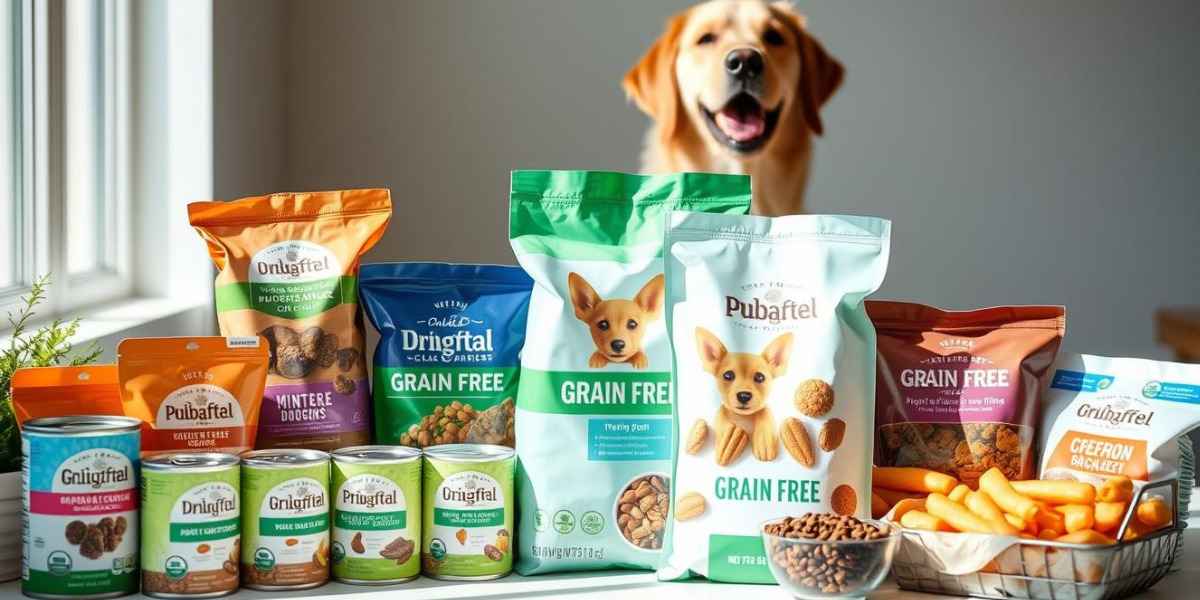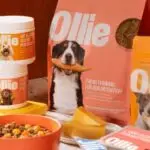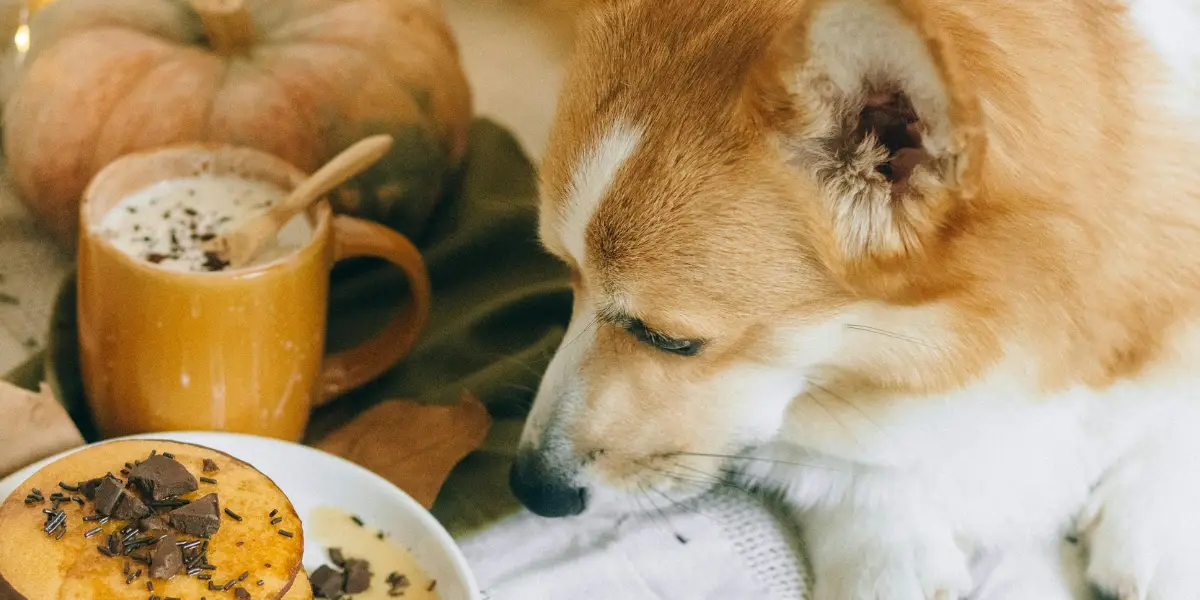Grain-free Pet Food: Nourish Your Pet Naturally
As a pet owner, you want the best for your furry friend. This includes a nutritious diet. Grain-free pet food is a popular choice in the US. It’s made with natural ingredients and lacks fillers, making it a healthier option than traditional pet food.
Choosing the best grain-free pet food is key. Look for top brands that offer high-quality ingredients and formulas.
Grain-free pet food
A neatly arranged display of a variety of grain-free pet food products, including canned, dry, and fresh options. The products are presented on a clean, white surface, with natural lighting gently illuminating the scene. The packaging features vibrant colors, clean designs, and prominent labels highlighting the “grain-free” claim. In the background, a soft, blurred image of a happy, healthy pet provides a sense of the intended audience and purpose of the display. The overall mood is one of natural, wholesome nourishment for pets.
Also Read
Grain-free pet food uses protein-rich ingredients like chicken, salmon, and beef. It doesn’t have grains like corn, wheat, or soy. This diet is good for pets with food sensitivities or allergies.
If you’re looking for the best grain-free pet food, talk to your vet. They can help find the right food for your pet’s needs. Top brands offer various formulas for different life stages and dietary needs.
Introduction to Grain-free Diets
Choosing the right grain-free pet food can be tough. It’s important to research and consider ingredient quality, nutritional content, and brand reputation. High-quality grain-free pet food supports your pet’s health and well-being.
Whether you have a dog or a cat, there are many great grain-free options. Top brands offer a wide range of formulas for different needs.
Key Takeaways
Grain-free pet food is a popular choice for pet owners in the US
Top grain-free pet food brands offer high-quality, natural ingredients
Grain-free diets can be beneficial for pets with food sensitivities or allergies
It’s essential to consult with your veterinarian to determine the best grain-free pet food for your pet
Consider factors such as ingredient quality and nutritional content when choosing a grain-free pet food
Top grain-free pet food brands provide a range of formulas for different life stages and dietary requirements
Understanding Grain-free Pet Food: A Comprehensive Guide
Grain-free pet food is getting more popular, and for good reasons. It can improve digestion and reduce allergies. This makes it a great choice for a natural diet for pets. But, what makes pet food grain-free, and how does it differ from traditional food?
Grain-free pet food often includes proteins like chicken, salmon, and lamb. It also has veggies like sweet potatoes and carrots. These ingredients give pets the nutrients they need without grains like corn, wheat, and rice. The debate is that grains aren’t natural for pets and can cause health issues.
Some key differences between grain-free and traditional pet food include:
Ingredient sourcing: Grain-free pet food uses better protein sources and avoids grains.
Nutritional content: Grain-free pet food has different nutritional levels than traditional food, with varying protein, fat, and carbs.
Manufacturing process: Grain-free pet food might be made differently, with unique cooking methods and ingredient handling.
grain-free pet food ingredients
A still life arrangement showcasing a variety of grain-free pet food ingredients on a rustic wooden table. In the foreground, a mixture of high-quality proteins such as shredded chicken, diced salmon, and ground lamb. The middle ground features colorful fruits and vegetables like diced sweet potatoes, shredded carrots, and whole blueberries. In the background, an assortment of leafy greens, nuts, and seeds. Soft, natural lighting illuminates the scene, casting warm shadows and highlighting the natural textures and colors of the ingredients. The overall mood is one of wholesome, nutritious nourishment for a pet’s optimal health and wellbeing.
Many pet owners see their pets’ health improve with grain-free food. They notice shinier coats, more energy, and fewer allergies. But, always talk to a vet before changing your pet’s diet. Every pet is different, and their needs can vary.
The Science Behind Grain-free Pet Nutrition
Grain-free pet food has become more popular lately. It’s because it offers many health benefits for pets. By taking grains out, it can lower the chance of food allergies and digestive issues. Pet nutrition is complex, but grain-free diets are a good choice for many pets.
Studies show grain-free diets are good for pets, especially those with food sensitivities. The science behind grain-free pet food is simple. It says grains aren’t needed in a pet’s diet. Many pets do well on grain-free diets, getting all the nutrients they need.
Grain-free diets can improve digestion, reduce inflammation, and lower disease risk. Choosing a grain-free diet can help pets live longer, healthier lives. The grain-free diet benefits are clear, and many pets have seen big health improvements.
When thinking about pet nutrition, each pet’s needs are different. Grain-free diets might not work for all, but they’re great for some. Understanding the science behind grain-free pet food helps pet owners make the best diet choices for their pets.
Benefits and Potential Concerns of Grain-free Diets
Grain-free pet food has become popular for its health benefits. It can improve digestion, reduce allergies, and boost energy. Many pets show better health after switching to grain-free diets.
But, there are concerns about grain-free diets. FDA studies suggest a link to heart disease in dogs. The FDA warns about the risks of grain-free diets.
When thinking about grain-free diets, consider these points:
Improved digestion and reduced allergy symptoms
Increased energy levels and improved overall health
Potential link to heart disease in dogs, as reported by FDA studies on grain-free pet food
Importance of consulting with a veterinarian before making any changes to a pet’s diet
Vets can guide on grain-free diets’ benefits and risks. They help pet owners make informed diet choices. This ensures pets get the nutrients they need and stay healthy.
It’s crucial to weigh grain-free food’s benefits against risks. Always talk to a vet before changing a pet’s diet. This way, pets get the right nutrients and avoid health problems.
Choosing the Right Grain-free Pet Food for Your Dog
Choosing the best grain-free dog food involves several factors. Your dog’s age, size, breed, and health are key. For example, puppies need more protein and calories than adult dogs. Senior dogs might need fewer calories and more support for their joints.
When picking grain-free pet food, consider the ingredients, nutritional content, and how it’s made. Look for foods rich in protein from animals like chicken, salmon, or lamb. They should also have whole vegetables and fruits. Always read labels to make sure the food meets your dog’s nutritional needs.
Here are some tips to help you choose:
Consult with your veterinarian to find the best grain-free dog food for your pet.
Research different brands and their ingredients, manufacturing processes, and nutritional content.
Read reviews from other pet owners to understand the food’s effectiveness and any drawbacks.
By carefully evaluating your options and considering your dog’s needs, you can find the best grain-free dog food. Always prioritize your dog’s individual requirements. If you have questions or concerns, don’t hesitate to ask your veterinarian.
Choosing the right grain-free pet food for your dog takes patience, research, and a commitment to their nutrition. By following these tips and considering your dog’s unique needs, you can make an informed decision. This will help your pet thrive on a grain-free diet.
Selecting Grain-free Options for Cats
Cats need special food, and picking the right grain-free cat food can be tough. With many choices, it’s key to think about your cat’s age and any special needs. This ensures they get the best nutrition.
Age-specific Recommendations
Kittens, adult cats, and seniors have different needs. Kittens need lots of protein and calories for growth. Seniors might need less food and more fiber for their health.
Some grain-free cat food brands have formulas for each age group. This makes picking the right food easier for your cat.
Special Dietary Considerations
Cats with food allergies or sensitivities might do well on grain-free food. Look for brands with simple ingredients or new protein sources like salmon or duck. Some brands also have special formulas for health issues like kidney disease or obesity.
Popular Grain-free Cat Food Brands
Well-known brands include Wellness, Taste of the Wild, and Blue Buffalo. They have many formulas for different ages, lifestyles, and diets. Always check the labels and talk to your vet to pick the best grain-free food for your cat.
When choosing grain-free cat food, remember these points:
Choose high-quality protein sources
Look for whole food ingredients
Avoid fillers and by-products
Find formulas that match your cat’s age and lifestyle
How to Transition Your Pet to Grain-free Food
Switching to grain-free pet food needs a careful plan to avoid upset stomachs. It’s important to be patient and watch how your pet reacts. A slow change helps your pet get used to the new food without discomfort.
Begin by adding a little grain-free food to their usual diet. Slowly increase the grain-free food over 7-10 days. Watching your pet’s response is key. Look for signs like diarrhea or vomiting and adjust the plan if needed.
Here are some tips for a smooth transition to grain-free food:
Divide your pet’s daily food into 2-3 meals to ease the change
Check your pet’s stool quality and adjust the plan if necessary
Always have fresh water available to prevent dehydration
By following a grain-free food transition plan and watching your pet, you can make the switch smoothly. Always talk to your vet if you have any worries or questions about changing your pet’s food.
Top Grain-free Pet Food Brands in the US Market
Choosing the right grain-free pet food is crucial for your pet’s health. Look for top grain-free pet food brands known for quality and nutrition. In the US, several grain-free pet food brands are leaders in pet care.
Brands like Orijen, Acana, and Blue Buffalo are among the best grain-free pet food companies. They offer grain-free options for all life stages and dietary needs. For example, Orijen’s dog food uses fresh, local ingredients. Acana’s cat food includes free-run chicken and wild-caught fish.
Here are some key features of these top brands:
High-quality protein sources, such as chicken, salmon, and beef
Whole fruits and vegetables, like apples, carrots, and sweet potatoes
No fillers or artificial preservatives
Choosing a trusted grain-free pet food brand in US ensures your pet gets the best nutrition. Always talk to your vet to find the right diet for your pet.
Reading and Understanding Grain-free Pet Food Labels
Choosing the right grain-free pet food is important. Reading grain-free pet food labels is key. You want to give your pet the best nutrition. So, you need to understand pet food ingredients and know how to analyze the label.
Analyze the label by looking at the real ingredients and nutritional content. Here are some tips to help you:
Ingredient Analysis Tips
Look for named protein sources, such as chicken or salmon
Check for whole food ingredients, such as sweet potatoes or carrots
Avoid fillers and by-products
Nutritional Content Requirements
Ensure the food meets your pet’s nutritional needs. This includes the right balance of protein, fat, and carbohydrates. Also, watch out for red flags like artificial preservatives or too much sodium.
Budget-friendly Grain-free Options and Where to Buy
Pet owners looking for grain-free pet food on a budget have many options. These affordable choices can be found in stores and online. This makes it easy to buy grain-free pet food that won’t empty your wallet.
Petco, PetSmart, and online sites like Chewy and Amazon carry affordable grain-free options. These places have a wide selection from different brands. This makes it simple to find the right food for your pet.
Many pet food brands also offer budget-friendly grain-free options on their websites. Brands like Blue Buffalo, Merrick, and Taste of the Wild have affordable choices. These options are not only cheap but also high in quality.
When searching for where to buy grain-free pet food, consider the food’s quality and ingredients. Choose brands with good protein sources like chicken or salmon. Avoid foods with fillers and by-products. This way, you can give your pet great nutrition without spending too much.
Conclusion: Making the Right Choice for Your Pet’s Nutrition
Grain-free pet food is a great choice for your furry friend. It’s natural and nourishing. Now, you know the science behind it and its benefits.
Choosing the right grain-free food is key. Look for high-quality brands that meet your pet’s needs. Check labels and consider your pet’s age, activity level, and health.
The right food can greatly improve your pet’s health. It supports digestion and boosts the immune system. With this knowledge, you can pick the best grain-free food for your pet.
FAQ
What is grain-free pet food?
Grain-free pet food doesn’t have grains like wheat, corn, or rice. Instead, it uses other carbs like potatoes, sweet potatoes, or legumes.
What are the benefits of feeding grain-free pet food?
Grain-free food can help with digestion and reduce allergy risks. It also aids in weight management. It’s good for pets sensitive to grains.
Are grain-free diets recommended by veterinarians?
Some vets suggest grain-free diets for pets with health issues. But, others worry about a heart condition called dilated cardiomyopathy (DCM) in dogs. Always check with your vet before switching.
What are the common ingredients in grain-free pet food?
Grain-free food often has carbs like potatoes, sweet potatoes, peas, or lentils. It also includes quality proteins like chicken, beef, or fish. Plus, it has fruits and veggies for nutrition.
How do I transition my pet to a grain-free diet?
Gradually introduce grain-free food over 7-10 days. Mix it with your pet’s current food at first. Slowly add more grain-free food. This prevents upset stomachs.
Where can I buy grain-free pet food?
You can find grain-free food at pet stores, online, and in grocery stores. Many popular brands offer grain-free options.
Are there any downsides to feeding a grain-free diet?
Grain-free diets can be good for some pets. But, they might increase the risk of dilated cardiomyopathy (DCM) in dogs. Choose a high-quality grain-free food and watch your pet’s health closely.









